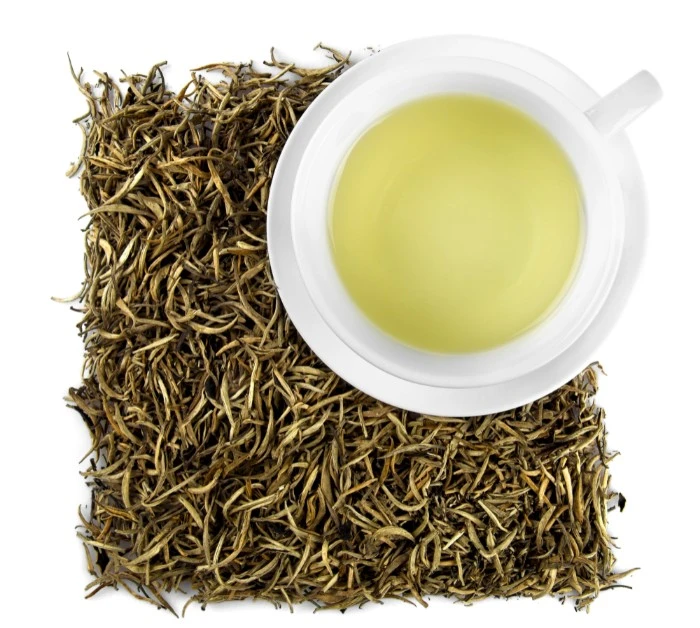Exceptionally flavorful tea with a lower caffeine content than other true tea types from the Camellia sinensis plant.
In this post, you’ll learn why drinking white tea is good for you, what are the most popular types of white tea, and how to brew it properly.
The first step is to define what white tea actually is!
This post may contain affiliate links, which means we may receive a small commission, at no cost to you, if you make a purchase through a link. For more information, please see our disclosure.
What is white tea?
White tea, like green tea, black tea, and oolong tea, is made from the Camellia sinensis plant. White tea is the least processed and, as a result, the most delicate of the tea types produced by the Camellia sinensis plant.
Despite the fact that it is mostly harvested in China’s Fujian province, there are also producers in Sri Lanka, Nepal, and Thailand.
Moreover, this tea’s distinctiveness is dependent on the timing of the harvest and processing.
High-quality white tea is harvested as soon as the dormant tea plants begin to produce their delicate buds in the early spring days. Because of the buds’ silvery-colored tiny hairs, it is known as white tea.
In most cases, the tea is made from a combination of buds and young leaves, which identifies the specific type.
White tea processing
After harvest, the not fully opened leaves and buds wither temporarily and turn a gray-green or gray-brown color due to very slight oxidation.
The oxidation process is extremely brief, even shorter than that used in the manufacturing of green tea. The longer a tea is allowed to oxidize (e.g. black tea), the darker it becomes. Additionally, this process alters the flavor of the tea. On the other hand, white tea undergoes relatively little modification.
They will then proceed directly to the drying stage. Although sun drying was the original approach, there are now additional mechanical drying processes available, such as basket drying.
White tea is the least processed tea. This same lack of processing works in favor of its benefits. That’s because it preserves the leaf’s antioxidant content to an even greater extent than green tea does.
What does white tea taste like?
White tea’s taste can be described as delicate, sweet, and fruity, but this all depends on the type of white tea you’re drinking. When brewed correctly, it doesn’t have a strong or bitter flavor.
It is worth noting that the taste of white tea can change a lot depending on which parts of the plant were used (buds or leaves), where it was grown, how it was processed, and even how it was brewed at a certain temperature.
Types of white tea
Many white tea types are available, with the following being among the most popular:
Silver Needle (Bai Hao Yin Zhen)
White tea known as Silver Needle is considered to be the best and most expensive type of white tea. Only silver-colored buds with a length of around 30 mm are used in the making of this tea.
An estimated 10 thousand buds are needed to produce 2.2 pounds (1 kilogram) of tea each spring, which is only gathered for a couple of weeks each year. Golden-hued, with a woodsy and flowery aroma, this sort of white tea is one of the most popular.
White Peony (Bai Mu Dan)
White Peony is the second-best white tea available. Buds are plucked along with the tender bit of the stem and top two leaves just below the bud. White Peony is less expensive than Silver N. variety.
The way the leaves unfurl as it steeps is said to resemble a white peony.
Compared to other types of white tea, this is more pale green in color and produces a slightly nutty aroma and aftertaste.
Long Life Eyebrow (Shou Mei)
The lower quality leaves are used to make this type of white tea. Long Life Eyebrow gets its common name from its thin, crescent-shaped leaves, which resemble eyebrows. This is a stronger white tea that is also darker in color.
Tribute Eyebrow (Gong Mei)
Gong Mei, also known as Tribute Eyebrow white tea, is harvested later than Silver N. tea and has a more robust flavor. This white tea has a strong, fruity flavor, similar to oolong teas.
Darjeeling White
Breaking away from China’s white tea production, Darjeeling white tea is produced in India’s Darjeeling region.
Brews to a pale golden color with a mellow flavor and little sweetness, the white Darjeeling tea has highly fluffy and light tea leaves and a delicate scent.
As for other white teas, there is a number to choose from, including Ceylon White from Sri Lanka; African White; Dragon Pearls; Snow Buds; and many more.
Stores commonly have white teas that have been flavored with fruity flavors, such as pomegranate white tea, hibiscus white tea, or peach white tea.
White tea benefits
Research on white tea and its compounds have connected it to an astounding array of health benefits, according to several scientific studies.
Let’s take a look at the white tea benefits that have been researched the most.
Rich in antioxidants
White tea contains a high level of polyphenols due to its minimal processing.
Polyphenols are plant-based molecules that act as antioxidants in the body, defending cells against harm produced by free radicals. A high level of free radical damage might be harmful to the body. It has been associated with aging, chronic inflammation, and a weak immune system.
White tea, according to a study published in Food Chemistry, has similar antioxidant properties to green tea.
Improves calmness, focus and alertness
Amino acid L-theanine is found in white tea. L-theanine may have a big impact on mood, performance, and brain health.
Also, white tea has less caffeine than other types of tea that have been more oxidized. If you don’t want to get jittery from too much caffeine, this is a good thing.
With less caffeine, you can drink several cups of white tea every day without having the same bad effects that strong cups of coffee can have.
May aid in the fight against skin aging
White tea and its compounds may help protect the skin from aging-related damage. This includes damage caused by the sun’s UV rays and internal damage caused by cellular components that may impact negatively on the skin’s fiber network.
Many studies have discovered that polyphenols can inhibit many cellular components that can cause harm to the fiber network that keeps the skin tight and firm.
Weight loss benefits
Catechins present in white tea have been shown to help burn fat cells and enhance metabolism, hence aiding in weight loss.
For instance, a test-tube study discovered that white tea extract stimulated fat breakdown and inhibited the formation of new fat cells. This is mostly because of epigallocatechin gallate (EGCG).
Additionally, a review of studies indicates that white tea may assist in increasing your metabolism by an additional 4-5%.
May help to lower the risk of heart disease
Consuming white tea may be beneficial to your heart!
Polyphenols, such as those present in white tea, may help relax blood vessels, promote immunity, and may prevent “bad” LDL cholesterol from becoming oxidized. These variables may contribute to a reduction in the risk of heart disease.
Bear in mind that it is also necessary to adopt other lifestyle modifications to maintain a healthy heart. These include consuming nutritious foods, engaging in regular physical activity, managing stress, and getting adequate rest.
Benefits for oral health
White tea has high concentrations of catechins, tannins, and fluoride. By combating bacteria and sugar, this mix of molecules can help strengthen teeth.
Fluoride is well-known as a prevention tool against tooth decay and is frequently contained in the toothpaste. It may help prevent dental cavities by strengthening the teeth’s surface against acid attacks by bacteria when combined with sugar.
Tannins are another type of polyphenol in white tea. Tannins and fluoride in combination may also limit the formation of plaque-causing bacteria, according to research.
*Note – If you are caffeine sensitive, reduce your white tea consumption to a minimum.
Avoid drinking white tea for at least an hour after a meal, especially if you suffer from anemia, as white tea inhibits iron absorption in your blood.
If you’re pregnant or breastfeeding, talk to your doctor before consuming white tea.
Caffeine content in white tea
White tea contains 6-55 mg of caffeine per cup (250 ml), however, this amount varies significantly based on a variety of factors. In comparison, coffee has around 95 mg of caffeine per cup, while green tea contains between 30 to 70 mg.
Related: Green Tea Caffeine Content
Moreover, the caffeine content of any beverage brewed from a caffeinated plant varies according to a variety of factors, including the location of the plant’s cultivation, its processing and the final method of brewing for your cup.
If you’re controlling your caffeine intake, always inquire about the caffeine content of the tea you’re purchasing from your seller.
*Note: Steeping white tea at temperatures exceeding 194°F (90°C) results in dramatically increased caffeine levels. The longer tea leaves or buds are steeped, the more caffeine is released from them.
Tea steeped for more than 7–10 minutes greatly increases its caffeine level, according to studies.
Tips and instructions for brewing white tea
The appropriate temperature and steeping time for each white tea might vary, so always check with your seller to get exact recommendations before steeping.
Ingredients
- 1 cup water
- For the best tasting use loose leaf or tea sachets
- For a tea made from buds: Use about 2 teaspoons of tea for every 8 ounces of water
- For a tea made from both buds and leaves: 1 tablespoon of tea for every 8 ounces of water
- For a tea made just from leaves: Use 2 tablespoons of tea for every 8 ounces of water
*Note – Always follow the box directions to determine the amount of tea to use for brewing.
Instructions
Boil water – When brewing tea, always begin with fresh, clean, cold filtered water. The best water is spring water. Set the temperature of an electric kettle with a temperature setting to 175°F (80°C) If using a stovetop, bring water to a simmer and then turn off the heat.
Steep – In a teapot, combine the white tea and hot water. Cover the teapot and allow it to steep. White tea steeps quickly in comparison to other teas.
Allow 30 seconds to 5 minutes for the loose leaf tea to infuse, depending on the variety of tea and your particular tastes.
Keep in mind that buds steep more slowly than larger leaves. Every 30 seconds, taste the tea to verify it has the desired flavor. Following that, you’ll be able to determine the ideal steeping period for your taste.
Keep in mind that the long white tea steeps, the stronger the flavor will be.
Strain tea leaves and pour the hot tea into a teacup – White tea is best drank without milk or sugar, but if you want it sweeter, you can add a little honey or sugar to your cup.
The takeaway
Finally, this refreshing and tasty tea is a perfect choice if you prefer tea with lower caffeine content. Rich in antioxidants it is especially good for your health.
No matter what type of white tea you’ll pick we are sure that you’ll enjoy your perfect cup of white tea and that you’ll add this tea to your list of favorite teas!

Disclaimer: While we have looked into the research on the health benefits of this tea, this is only for informational purposes and should not be construed as medical advice. Those with health-related questions should seek the advice of a medical professional.




